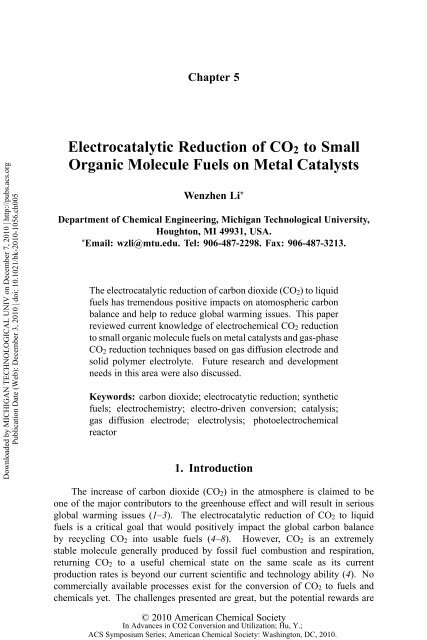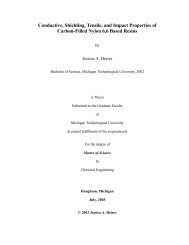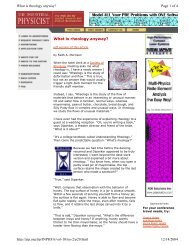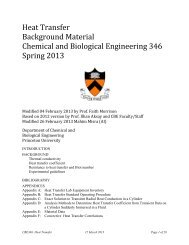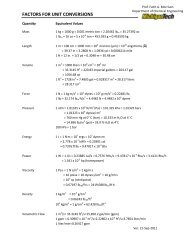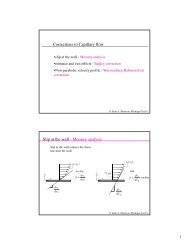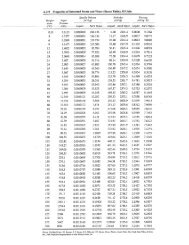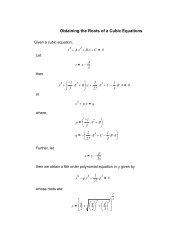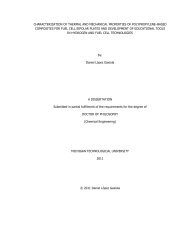Electrocatalytic Reduction of CO2 to Small Organic Molecule Fuels ...
Electrocatalytic Reduction of CO2 to Small Organic Molecule Fuels ...
Electrocatalytic Reduction of CO2 to Small Organic Molecule Fuels ...
Create successful ePaper yourself
Turn your PDF publications into a flip-book with our unique Google optimized e-Paper software.
Chapter 5<br />
Downloaded by MICHIGAN TECHNOLOGICAL UNIV on December 7, 2010 | http://pubs.acs.org<br />
Publication Date (Web): December 3, 2010 | doi: 10.1021/bk-2010-1056.ch005<br />
<strong>Electrocatalytic</strong> <strong>Reduction</strong> <strong>of</strong> CO 2 <strong>to</strong> <strong>Small</strong><br />
<strong>Organic</strong> <strong>Molecule</strong> <strong>Fuels</strong> on Metal Catalysts<br />
Wenzhen Li *<br />
Department <strong>of</strong> Chemical Engineering, Michigan Technological University,<br />
Hough<strong>to</strong>n, MI 49931, USA.<br />
*Email: wzli@mtu.edu. Tel: 906-487-2298. Fax: 906-487-3213.<br />
The electrocatalytic reduction <strong>of</strong> carbon dioxide (CO 2 ) <strong>to</strong> liquid<br />
fuels has tremendous positive impacts on a<strong>to</strong>mospheric carbon<br />
balance and help <strong>to</strong> reduce global warming issues. This paper<br />
reviewed current knowledge <strong>of</strong> electrochemical CO 2 reduction<br />
<strong>to</strong> small organic molecule fuels on metal catalysts and gas-phase<br />
CO 2 reduction techniques based on gas diffusion electrode and<br />
solid polymer electrolyte. Future research and development<br />
needs in this area were also discussed.<br />
Keywords: carbon dioxide; electrocatytic reduction; synthetic<br />
fuels; electrochemistry; electro-driven conversion; catalysis;<br />
gas diffusion electrode; electrolysis; pho<strong>to</strong>electrochemical<br />
reac<strong>to</strong>r<br />
1. Introduction<br />
The increase <strong>of</strong> carbon dioxide (CO 2 ) in the atmosphere is claimed <strong>to</strong> be<br />
one <strong>of</strong> the major contribu<strong>to</strong>rs <strong>to</strong> the greenhouse effect and will result in serious<br />
global warming issues (1–3). The electrocatalytic reduction <strong>of</strong> CO 2 <strong>to</strong> liquid<br />
fuels is a critical goal that would positively impact the global carbon balance<br />
by recycling CO 2 in<strong>to</strong> usable fuels (4–8). However, CO 2 is an extremely<br />
stable molecule generally produced by fossil fuel combustion and respiration,<br />
returning CO 2 <strong>to</strong> a useful chemical state on the same scale as its current<br />
production rates is beyond our current scientific and technology ability (4). No<br />
commercially available processes exist for the conversion <strong>of</strong> CO 2 <strong>to</strong> fuels and<br />
chemicals yet. The challenges presented are great, but the potential rewards are<br />
© 2010 American Chemical Society<br />
In Advances in <strong>CO2</strong> Conversion and Utilization; Hu, Y.;<br />
ACS Symposium Series; American Chemical Society: Washing<strong>to</strong>n, DC, 2010.
Downloaded by MICHIGAN TECHNOLOGICAL UNIV on December 7, 2010 | http://pubs.acs.org<br />
Publication Date (Web): December 3, 2010 | doi: 10.1021/bk-2010-1056.ch005<br />
enormous. To address this challenging scientific problem, we need <strong>to</strong> advance<br />
our fundamental understanding <strong>of</strong> the chemistry <strong>of</strong> CO 2 activation and develop<br />
novel multifunctional catalysts that could use electricity <strong>to</strong> efficiently break C-O<br />
bond and form C-H and C-C bonds (4). Appropriate energy input and reasonable<br />
productivity <strong>of</strong> fuels are also important considerations for practical industrial<br />
processes.<br />
The CO 2 electrocatalytic reductions <strong>to</strong> usable fuels are ‘reverse’<br />
electrochemical processes compared <strong>to</strong> the anode reactions occurred in fuel<br />
cells. CO 2 reduction converts electrical energy back <strong>to</strong> chemical energy s<strong>to</strong>red<br />
in the chemical bonds <strong>of</strong> fuels. In thermodynamics, the Gibbs free energy<br />
<strong>of</strong> CO 2 reduction is always positive at medium and high pH range, and the<br />
theoretical potentials are negative. Thus, CO 2 reduction is an electrolysis process<br />
that requires electrical energy input. In kinetics, the overpotential needed <strong>to</strong><br />
electrochemically reduce CO 2 is always > 1.0 V, <strong>to</strong> get reasonable amounts<br />
<strong>of</strong> fuels, such as methane, ethylene, etc. In an aqueous electrolyte, the water<br />
reduction always occurs, and H 2 is a major by-product accompanied with CO 2<br />
reduction. High hydrogen overvoltage metals, such as Hg, can suppress H 2<br />
evolution, but it leads <strong>to</strong> formation <strong>of</strong> formate ions (HCOO - ) at very high<br />
overpotentials (high energy cost).<br />
A miles<strong>to</strong>ne work is that Hori group found the CO 2 reduction on copper<br />
(Cu) behaves very different from the other metals. Cu can directly reduce CO 2 <strong>to</strong><br />
hydrocarbons (mainly methane and ethylene) with reasonable current density (i.e.<br />
5-10 mA/cm 2 ) and current efficiency (i.e. > 69% at 0°C) in aqueous electrolyte<br />
(6, 9). Cu-based catalysts (Cu single crystals, ada<strong>to</strong>m Cu electrode, and Cu alloys<br />
electrodes) have been extensively studied from both fundamental and applied<br />
perspectives (9–17). Although the process has not been commercialized <strong>to</strong><br />
produce hydrocarbon products yet, gas mixtures <strong>of</strong> hydrogen, methane, ethylene<br />
and CO would form ‘hythane’ that can be promoted as alternative fuel for existing<br />
vehicles (18).<br />
CO 2 reduction in gas phase based on gas diffusion electrode (GDE) and solid<br />
polymer electrolyte (SPE) can greatly improve CO 2 transport, thus facilitating<br />
CO 2 reduction (19–23). Taking the advantages <strong>of</strong> established electrolysis cell<br />
and fuel cell technologies, electrocatalytic recycling <strong>of</strong> CO 2 and small organic<br />
molecule fuels appears <strong>to</strong> be a promising means <strong>to</strong> achieving sustainable, carbon<br />
neutral energy conversions. Recently, surprising long carbon chain organic<br />
molecules, such as iso-propanol and C ≥4 oxygenates, were found in the GDE<br />
based electrocatalytic reduction <strong>of</strong> CO 2 based on CNT-encapsulate metal catalysts<br />
(24, 25), although in very small amounts, they might open new avenues <strong>to</strong> CO 2<br />
electrocatalytic conversion <strong>to</strong> liquid fuels.<br />
Some excellent review articles are already available in this field. Frese<br />
reviews CO 2 electrocatalytic reduction on solid electrodes (5), Gattrell focused on<br />
fundamental mechanisms <strong>of</strong> electrochemical reduction <strong>of</strong> CO 2 <strong>to</strong> hydrocarbons<br />
on copper electrode in aqueous electrolyte solution (6), and Hori recently gave<br />
a comprehensive review on CO 2 reduction on metal electrodes based on his<br />
pioneer work in this area (7). This paper will introduce current knowledge <strong>of</strong><br />
electrochemical CO 2 reduction on heterogeneous metal catalysts, review present<br />
CO 2 reduction techniques based on GDE and SPE, and discuss future research and<br />
56<br />
In Advances in <strong>CO2</strong> Conversion and Utilization; Hu, Y.;<br />
ACS Symposium Series; American Chemical Society: Washing<strong>to</strong>n, DC, 2010.
development needs in this area. Although homogeneous catalysis is an efficient<br />
approach <strong>to</strong> CO 2 reduction (8), it is out <strong>of</strong> the scope <strong>of</strong> this paper.<br />
2. Review<br />
2.1. Fundamental Challenges for Electrochemical <strong>Reduction</strong> <strong>of</strong> CO 2<br />
Downloaded by MICHIGAN TECHNOLOGICAL UNIV on December 7, 2010 | http://pubs.acs.org<br />
Publication Date (Web): December 3, 2010 | doi: 10.1021/bk-2010-1056.ch005<br />
The products <strong>of</strong> CO 2 reduction vary from liquid fuels (i.e. formic acid and<br />
isopropanol), hydrocarbons (i.e. methane and ethylene) <strong>to</strong> fuel precursors (i.e.<br />
CO). The reactivity <strong>of</strong> CO 2 reduction is very low, however, the equilibrium<br />
potentials <strong>of</strong> CO 2 reduction are not very negative (equation 123456), compared <strong>to</strong><br />
hydrogen evolution reaction (HER) in aqueous electrolyte solutions (equation 7).<br />
The primary reactions that occurred on electrode in aqueous solution at pH 7.0 at<br />
25°C, versus standard hydrogen electrode (SHE) are shown below (7, 26):<br />
CO 2 reduction does not occur easily and the real applied electrolysis potentials<br />
for CO 2 reduction are more negative than the equilibrium values. This is mainly<br />
because the single electron reduction <strong>of</strong> CO 2 <strong>to</strong> CO 2·- (equation 8), which has been<br />
well recognized as the first step <strong>to</strong> activate CO 2 for subsequent reduction steps,<br />
occurs at -1.90 V, due <strong>to</strong> a large reorganizational energy between linear molecule<br />
and bent radical anion. This step has also been determined as the rate determining<br />
step (RDS) for CO 2 reduction.<br />
It should be noted that the theoretical equilibrium potentials decrease with pH<br />
increasing, governed by the Nernst equation (6). For example, the equilibrium<br />
57<br />
In Advances in <strong>CO2</strong> Conversion and Utilization; Hu, Y.;<br />
ACS Symposium Series; American Chemical Society: Washing<strong>to</strong>n, DC, 2010.
potential is +0.17 V for CO 2 reduction <strong>to</strong> methane at pH 0 (Equation 9). The<br />
equilibrium potentials over the range <strong>of</strong> pH values around where the reactions are<br />
typically carried out are shown in Fig. 1.<br />
Downloaded by MICHIGAN TECHNOLOGICAL UNIV on December 7, 2010 | http://pubs.acs.org<br />
Publication Date (Web): December 3, 2010 | doi: 10.1021/bk-2010-1056.ch005<br />
The key problem <strong>of</strong> the conversion <strong>of</strong> CO 2 <strong>to</strong> liquid fuels is the assembly<br />
<strong>of</strong> the nuclei and formation <strong>of</strong> chemical bonds <strong>to</strong> convert the relatively simple<br />
CO 2 molecule in<strong>to</strong> more complex and energetic molecules. The CO 2 reduction is<br />
greatly limited by reaction kinetics. Considering their low equilibrium potentials<br />
as shown in Fig. 1, thermodynamically, the products <strong>of</strong> methane and ethylene<br />
should occur at a less cathodic potential than hydrogen, however, kinetically this<br />
does not happen.<br />
The products distribution for CO 2 reduction on Cu electrode as a function<br />
<strong>of</strong> potential is plotted in Fig. 2. Initially, CO 2 reduction produces CO and<br />
formate until below -1.12V, where hydrocarbons begin <strong>to</strong> form, with first ethylene<br />
(C 2 H 4 ), then methane (CH 4 ) appearing. The methane production shows the<br />
stronger potential dependence, and these reactions accelerate, dominating over<br />
CO and formate at around -1.35V. Therefore, the fundamental challenges for CO 2<br />
reduction come from both thermodynamics and kinetics.<br />
In addition, hydrogen evolution reaction (HER) takes place in aqueous<br />
electrolytes by cathodic polarization, competing with CO 2 reduction, HER<br />
is prevalent in acidic solutions, while CO 2 does not exist in a basic solution.<br />
Therefore, most CO 2 reduction study was conducted in close neutral electrolyte<br />
solutions (i.e. 0.05 – 0.5 M NaHCO 3 ).<br />
2.2. Classification <strong>of</strong> <strong>Electrocatalytic</strong> Metals and Reaction Selectivity<br />
The product selectivity in CO 2 reduction depends on many fac<strong>to</strong>rs, such as<br />
concentration <strong>of</strong> the reactants, electrode potential, temperature, electrocatalyst<br />
material and electrolyte solution (i.e. aqueous or non-aqueous electrolyte). As<br />
widely accepted by most researchers, the electrocatalyst materials govern the<br />
selectivity <strong>of</strong> CO 2 reduction, when the other conditions are identical. Hori’s<br />
group has carried out a series <strong>of</strong> elegant research on CO 2 reduction (9–13), and<br />
found electrocatalytic metals can be generally divided in<strong>to</strong> four groups based on<br />
product selectivity, as shown in Table 1.<br />
The 1 st group metals include Pb, Hg, In, Sn, Cd, TI, Bi, etc. They have<br />
high hydrogen overvoltages, negligible CO adsorption properties, and high<br />
overvoltages for CO 2 <strong>to</strong> CO 2·-, and hence weak stabilization <strong>of</strong> CO 2·-. The major<br />
product is formate ion (HCOO - ).<br />
The 2 nd group metals include Au, Ag, Zn, etc. They have medium hydrogen<br />
overvoltages and weak CO adsorption properties, and the major product is carbon<br />
monoxide (CO). Because they can catalyze the breakage <strong>of</strong> the C-O bond in CO 2<br />
but allow the CO desorb, thus, the major product is CO.<br />
The 3 rd group metals include Ni, Fe, Pt, Ti, etc. They have low hydrogen<br />
overvoltages and strong CO adsorption properties and the major product is H 2 ,<br />
because the main reaction is water reduction <strong>to</strong> H 2 .<br />
58<br />
In Advances in <strong>CO2</strong> Conversion and Utilization; Hu, Y.;<br />
ACS Symposium Series; American Chemical Society: Washing<strong>to</strong>n, DC, 2010.
Downloaded by MICHIGAN TECHNOLOGICAL UNIV on December 7, 2010 | http://pubs.acs.org<br />
Publication Date (Web): December 3, 2010 | doi: 10.1021/bk-2010-1056.ch005<br />
Figure 1. The equilibrium potentials as a function <strong>of</strong> pH for the principal CO 2<br />
reduction reaction at 25°C (Ref. (7)). Copyright (2007) with permission from<br />
Elsevier.<br />
Figure 2. Partial current data obtained from high-purity Cu electrode from<br />
Ref (7), conditions: 0.1 M KHCO 3 , 19°C, CO 2 bubbled, [H + ]=1.55×10 -7 M,<br />
[CO 2 ]=3.41×10 -2 M. Copyright (2007) with permission from Elsevier.<br />
The 4 th group: Cu. Cu is unique for CO 2 reduction, because it is able <strong>to</strong> further<br />
react CO <strong>to</strong> more reduced species, such as CH 4 and C 2 H 4 with significant amounts.<br />
The detailed mechanisms are discussed in section 2.3.<br />
Azuma et al. applied 32 metals <strong>to</strong> CO 2 reduction at similar conditions (-2.2<br />
V vs. SCE, 0.05M KHCO 3 ) and confirmed these results given in Table 1 (from<br />
Hori’s group). They showed that Cu is the unique metal that can reduce CO 2 <strong>to</strong><br />
appreciable amounts <strong>of</strong> hydrocarbons CH 4 and C 2 H 4 , while Ni and Pt catalysts<br />
59<br />
In Advances in <strong>CO2</strong> Conversion and Utilization; Hu, Y.;<br />
ACS Symposium Series; American Chemical Society: Washing<strong>to</strong>n, DC, 2010.
Downloaded by MICHIGAN TECHNOLOGICAL UNIV on December 7, 2010 | http://pubs.acs.org<br />
Publication Date (Web): December 3, 2010 | doi: 10.1021/bk-2010-1056.ch005<br />
scarcely give products in CO 2 reduction at ambient temperature and pressure, but<br />
can reduce CO 2 <strong>to</strong> CO or formic acid under elevated pressure (i.e. 60 atm). They<br />
also provided a classical roadmap for CO 2 electrocatalytic reduction on metal<br />
catalysts (16), which can be found in Ref (16).<br />
It is interesting that the presence <strong>of</strong> small amount <strong>of</strong> foreign a<strong>to</strong>ms on the<br />
electrode surface could greatly change the reaction selectivity <strong>of</strong> CO 2 reduction<br />
(6, 27). These ada<strong>to</strong>m modified electrodes were prepared by under potential<br />
deposition or overpotential deposition techniques. For example, at -1.44 V vs<br />
SHE, the CO selectivity <strong>of</strong> pure Cu is 69%, while that <strong>of</strong> Cd and Pd ada<strong>to</strong>m<br />
modified Cu is 82% and 0, respectively.<br />
2.3. Reaction Mechanisms<br />
The CO 2 reduction on various metal electrodes has been extensively studied,<br />
but knowledge about <strong>CO2</strong> reduction is still limited, the reaction mechanisms were<br />
mainly obtained base on observed charge transfer coefficients and reaction orders<br />
acquired from macroscopic electrochemical testing. The partially unders<strong>to</strong>od<br />
reaction mechanisms are discussed as follows.<br />
a. Formation <strong>of</strong> CO 2 ·- Is the Rate-Determining Step (RDS)<br />
The CO 2 can be chemisorbed as a bent CO 2<br />
δ- molecule, which is promoted<br />
by surface defects, alkali metal promoted surfaces, and possibly through X-rays<br />
or pho<strong>to</strong>electrons during measurements. The exact geometry <strong>of</strong> CO 2<br />
δ- metal<br />
is unclear, and the possible structures for adsorbed CO 2<br />
δ- are shown in Fig. 3.<br />
CO 2 is an ‘amphoteric’ molecule possessing both acid and basic properties. The<br />
adsorption and stabilization <strong>of</strong> CO 2<br />
δ- are dominantly governed by the electrode<br />
metals. The electrode metals interact with carbon or oxygen or both in CO 2<br />
<strong>to</strong> form carbon coordination or oxygen coordination, or mixed coordination<br />
adsorption mode, respectively. The CO 2<br />
δ- species is most easily produced at<br />
surface defects or in the presence <strong>of</strong> sublyer coverage <strong>of</strong> an alkali metal. It<br />
is generally agreed that the formation <strong>of</strong> CO 2·- is the rate-determining step at<br />
medium and high overpotential regions. Jordan and Smith firstly proposed the<br />
formation <strong>of</strong> CO 2·- anion radical by one electron transfer <strong>to</strong> CO 2 is the initial step<br />
for subsequent reduction <strong>of</strong> CO 2 , as shown in Fig. 4 (a) (28). Pacansky et al.<br />
studied scf ab initio molecular orbital energies and a<strong>to</strong>mic population analysis <strong>of</strong><br />
CO 2·- at the minimum energy geometry and found the unpaired electron density<br />
at the highest occupied orbital is localized at C a<strong>to</strong>m at 84% (29). This result<br />
suggests that CO 2·- is ready <strong>to</strong> react as a nucleophilic reactant at the carbon a<strong>to</strong>m.<br />
The standard potential <strong>of</strong> CO 2·- formation is -1.90 V or -1.85 V vs SHE, -2.21 V<br />
vs. SCE in aqueous media (30–32). The transfer coefficient <strong>of</strong> RDS in the lower<br />
overvoltage region was found <strong>to</strong> be 0.67 (33). The CO 2 . - is mostly present freely<br />
in both aqueous and non-aqueous electrolyte solutions, and has been captured by<br />
ultraviolet spectroscopy (34).<br />
60<br />
In Advances in <strong>CO2</strong> Conversion and Utilization; Hu, Y.;<br />
ACS Symposium Series; American Chemical Society: Washing<strong>to</strong>n, DC, 2010.
Downloaded by MICHIGAN TECHNOLOGICAL UNIV on December 7, 2010 | http://pubs.acs.org<br />
Publication Date (Web): December 3, 2010 | doi: 10.1021/bk-2010-1056.ch005<br />
61<br />
Table 1. Faradaic efficiencies <strong>of</strong> products in CO 2 reduction at various metal electrodes. Electrolyte: 0.1 M KHCO 3 (T = 18.5 ± 0.5°C,<br />
Ref. (12)). Copyright (1995) with permission from Elsevier.<br />
In Advances in <strong>CO2</strong> Conversion and Utilization; Hu, Y.;<br />
ACS Symposium Series; American Chemical Society: Washing<strong>to</strong>n, DC, 2010.
Figure 3. Possible structure for adsorbed CO 2<br />
δ- on metals (Ref (7)). Copyright<br />
(2007) with permission from Elsevier.<br />
Downloaded by MICHIGAN TECHNOLOGICAL UNIV on December 7, 2010 | http://pubs.acs.org<br />
Publication Date (Web): December 3, 2010 | doi: 10.1021/bk-2010-1056.ch005<br />
Figure 4. The main reaction pathways at the electrode surface, with adsorbed<br />
blocking the majority <strong>of</strong> the surface and hydrocarbon products being formed<br />
by the further reduction <strong>of</strong> adsorbed CO. (Ref (6, 7). Copyright (2007) with<br />
permission from Elsevier. (see color insert)<br />
There are two main pathways for further reduction <strong>of</strong> adsorbed CO 2·- <strong>to</strong><br />
respective final product <strong>of</strong> CO, and formate ion (HCOO - ), which is governed by<br />
the properties <strong>of</strong> metal electrocatalysts.<br />
b. Formation <strong>of</strong> Adsorbed CO 2·-Leading <strong>to</strong> Further <strong>Reduction</strong> <strong>to</strong> HCOO -<br />
Erring et al. studied CO 2 reduction polarization data at Hg electrode in<br />
aqueous electrolyte with HCO 3<br />
-, and obtained a major product <strong>of</strong> HCOO - (35).<br />
On Hg, CO 2 reduction is initiated by one electron transfer <strong>to</strong> form CO 2·- at the<br />
potential negative <strong>of</strong> −1.6 V vs. SHE. The CO 2·- will take a pro<strong>to</strong>n from a H 2 O<br />
molecule at the nucleophilic carbon a<strong>to</strong>m, forming HCOO·. H + will not be bonded<br />
<strong>to</strong> the O a<strong>to</strong>m <strong>of</strong> CO 2·-, since pKa value <strong>of</strong> the acid-base couple (CO 2·-/CO 2 H) is<br />
low <strong>of</strong> 1.4 (36). Hori et al found that the electrode potential is constant as the<br />
current density for HCOO - formation at a pH range <strong>of</strong> 2-8, thus, H 2 O is believed <strong>to</strong><br />
be the pro<strong>to</strong>n donor in the formate formation from CO 2·-. HCOO· is subsequently<br />
reduced <strong>to</strong> HCOO − at the electrode in aqueous media. The reaction steps are:<br />
62<br />
In Advances in <strong>CO2</strong> Conversion and Utilization; Hu, Y.;<br />
ACS Symposium Series; American Chemical Society: Washing<strong>to</strong>n, DC, 2010.
Formate could also be produced directly by reaction with adsorbed hydrogen,<br />
which would be present as an intermediate in the hydrogen evolution reaction:<br />
Downloaded by MICHIGAN TECHNOLOGICAL UNIV on December 7, 2010 | http://pubs.acs.org<br />
Publication Date (Web): December 3, 2010 | doi: 10.1021/bk-2010-1056.ch005<br />
Such a reaction mechanism would appear <strong>to</strong> be favored by CO 2·- being<br />
adsorbed with oxygen coordination or being just close <strong>to</strong> the electrode. Other<br />
high hydrogen overvoltage electrodes, including Cd, Pb, Tl, In, and Sn, with<br />
weak adsorption <strong>of</strong> hydrogen, have high overvoltage for CO 2 reduction <strong>to</strong> CO 2·-,<br />
and hence weak stabilization <strong>of</strong> CO 2·-. The CO 2 reduction on these metals follows<br />
a similar mechanism as shown in Fig. 4 (b). In non-aqueous electrolyte, CO 2<br />
electrolysis on Pb leads <strong>to</strong> formation <strong>of</strong> oxalic acid, due <strong>to</strong> formation <strong>of</strong> (CO 2 ) 2·-<br />
(6).<br />
c. Formation <strong>of</strong> Adsorbed CO 2·-Leading <strong>to</strong> Further <strong>Reduction</strong> <strong>to</strong> CO<br />
The other pathway also involves first pro<strong>to</strong>nation then reduction, which is<br />
similar <strong>to</strong> step b), however, the hydrogen appears <strong>to</strong> be added on oxygen not carbon<br />
in CO 2·-. The steps will occur more favorably on carbon coordination adsorption<br />
mode.<br />
CO could be formed by a direct reaction with adsorbed hydrogen:<br />
In these reactions, the electrophilic reagents, H 2 O in aqueous solution, react<br />
with the O a<strong>to</strong>m <strong>of</strong> adsorbed CO 2·-, forming CO ads and OH − as depicted in Fig. 4(c).<br />
Sasaki et al used an ab initio molecular orbital approach <strong>to</strong> study the configuration<br />
<strong>of</strong> NiF(NH 3 ) 4 (CO 2 ) as a model for CO 2 reduction and showed that C a<strong>to</strong>m <strong>of</strong> CO 2<br />
molecule is favorably coordinated with the transition metal a<strong>to</strong>m in a complex and<br />
can be stabilized by a strong charge transfer due <strong>to</strong> back donation from Ni <strong>to</strong> CO 2 ,<br />
which indicates carbon coordination can facilitate pro<strong>to</strong>nation <strong>of</strong> oxygen (Eq.13),<br />
leading <strong>to</strong> formation <strong>of</strong> ·COOH not HCOO·.<br />
At Au electrode, H + will not take part in the CO formation, since the partial<br />
current <strong>of</strong> CO formation is independent <strong>of</strong> pH. The CO ads is readily desorbed from<br />
63<br />
In Advances in <strong>CO2</strong> Conversion and Utilization; Hu, Y.;<br />
ACS Symposium Series; American Chemical Society: Washing<strong>to</strong>n, DC, 2010.
the electrode as a gaseous molecule. The reaction scheme is suitable <strong>to</strong> other<br />
metal electrodes, such as Ag, Cu and Zn in aqueous media. The sequence <strong>of</strong> CO<br />
selectivity roughly agrees with that <strong>of</strong> the electrode potentials. This agreement<br />
verifies the hypothesis that CO is favorably produced from the electrode metals<br />
which stabilize CO 2·- effectively. Because the CO adsorption on Au, Ag and Zn<br />
surface is weak, CO is the major product, as shown in Fig. 4 c. In comparasion,<br />
CO will be further reduced <strong>to</strong> hydrocarbon products on Cu electrode (as discussed<br />
in section 2.4).<br />
Downloaded by MICHIGAN TECHNOLOGICAL UNIV on December 7, 2010 | http://pubs.acs.org<br />
Publication Date (Web): December 3, 2010 | doi: 10.1021/bk-2010-1056.ch005<br />
d. Hydrogen Evolution Reaction (HER)<br />
HER is a major side reaction that accompanies CO 2 reduction in an aqueous<br />
electrolyte. It has been found that the reaction kinetics <strong>of</strong> HER are pH dependent<br />
in the acid region and pH independent in the alkaline region. The HER can be<br />
written as<br />
Adsorbed hydrogen H ads and/or H + are the hydrogen source for hydrogenation<br />
in CO 2 reduction. Because CO is strongly adsorbed on Pt/Fe/Ni/Ti surface, in an<br />
applied potential range, the major product is H 2 , rather than CO, as shown in Fig.<br />
4 d.<br />
2.4. Cu-Based Electrocatalysts<br />
Cu is a unique metal that can reduce CO 2 <strong>to</strong> CH 4 and C 2 H 4 and alcohols<br />
in aqueous electrolyte at low temperature (6). Some known mechanisms are<br />
reviewed as below.<br />
a. Formation <strong>of</strong> CO ads as Reaction Intermediate<br />
From Fig. 2, at low overpotential, i.e. -0.9 V, the faradic yields <strong>of</strong> CO and<br />
HCOO - are both appreciable, while C 2 H 4 begins <strong>to</strong> increase at -1.1V, CH 4 starts at<br />
-1.2V, these data indicate that CO and HCOO - may be precursors <strong>to</strong> hydrocarbons<br />
and alcohols. However, FTIR and Raman spectrum show CO is linearly adsorbed<br />
on Cu polycrystal electrode at -0.6V, which suggests that CO is the reaction<br />
intermediate formed at Cu electrode, serving as a precursor for further reduction<br />
<strong>to</strong> hydrocarbons and alcohols (37, 38). The surface <strong>of</strong> the Cu electrode is covered<br />
by CO with coverage >90% as estimated from the current at -1.0V with and<br />
64<br />
In Advances in <strong>CO2</strong> Conversion and Utilization; Hu, Y.;<br />
ACS Symposium Series; American Chemical Society: Washing<strong>to</strong>n, DC, 2010.
without CO, this could severely suppress hydrogen evolution reaction. The heat<br />
<strong>of</strong> adsorption <strong>of</strong> CO on Cu is appropriate (-17.7 kcal/mol), which is higher than<br />
Au, but lower than Ni and Pt, as listed in Table 2 (39). Therefore, Cu allows<br />
efficiently subsequent reduction <strong>of</strong> CO <strong>to</strong> produce hydrocarbons and alcohols.<br />
b. From CO ads <strong>to</strong> Hydrocarbons<br />
Downloaded by MICHIGAN TECHNOLOGICAL UNIV on December 7, 2010 | http://pubs.acs.org<br />
Publication Date (Web): December 3, 2010 | doi: 10.1021/bk-2010-1056.ch005<br />
Since CO has been identified as a primary reaction intermediate for formation<br />
<strong>of</strong> hydrocarbons, CO was used <strong>to</strong> investigate mechanisms <strong>of</strong> CO 2 reduction on<br />
Cu. Fig. 2 suggests that CH 4 formation starts at a more negative potential than<br />
C 2 H 4 (-1.22 vs -1.12 V), but C 2 H 4 formation is more favorable in high pH media.<br />
In addition, the Tafel slope for the two reactions are very different. All these<br />
strongly indicate that formation <strong>of</strong> CH 4 and C 2 H 4 is through different reaction<br />
pathways from common starting substance CO. Interestingly, the evidence <strong>of</strong> lack<br />
<strong>of</strong> formation <strong>of</strong> methanol implies that the C-O bond <strong>of</strong> CO is broken early and<br />
consistently in the mechanism.<br />
For the case <strong>of</strong> formation <strong>of</strong> CH 4 , the transfer efficient <strong>of</strong> > 1 suggests that<br />
there is an initial electron transfer in equilibrium before RDS, this could result in<br />
a CO anion radical, as shown in Fig. 5 (a). Ab initio calculations were used <strong>to</strong><br />
evaluate the state <strong>of</strong> the adsorbed CO anion radical, a slight decrease <strong>of</strong> the Cu-C<br />
bond and an increase <strong>of</strong> the C-O bond <strong>to</strong> about 1.25 Å were found, this predicts a<br />
mostly double bond character (40).<br />
There are two possible reaction paths after formation <strong>of</strong> CO anion radicals.<br />
The first path is shown in Fig. 5 (b). This path involves a pro<strong>to</strong>n in the reaction,<br />
which must occur reversibly before the second electron transfer for RDS <strong>to</strong> yield<br />
the observed transfer coefficient. This is an acid-base reaction at the oxygen. The<br />
formation <strong>of</strong> four C-H bond would be not reversible, leading <strong>to</strong> production <strong>of</strong><br />
CH 4 . The second path involves reaction <strong>of</strong> C-O anion radical with an adsorbed<br />
hydrogen. Once the adsorbed CO has been electrochemically split, the hydrogen<br />
will add on carbon <strong>to</strong> form C-H radical and result in formation <strong>of</strong> CH 4 , as shown<br />
in Fig. 5(c).<br />
For the case <strong>of</strong> C 2 H 4 formation, ethylene formation begins at a lower potential<br />
without a pH dependence and with first electron transfer as the RDS. As the first<br />
electron transfer begins a reaction pathway that subsequently results in a two<br />
carbon product, it is reasonable <strong>to</strong> assume that some type <strong>of</strong> bond formation occurs<br />
in this reaction step. A reaction is proposed that involves a “prior association” <strong>of</strong><br />
two adsorbed CO (see Fig. 6). The postulation <strong>of</strong> a starting “associated pair” <strong>of</strong><br />
adsorbed CO also would be consistent with the lower activation potential vs. the<br />
formation <strong>of</strong> CO (and hence methane).<br />
The other possible reaction path is through the step <strong>of</strong> –CH 2 (ads) with CO.<br />
Since C(ads) is readily reduce <strong>to</strong> –CH 2 as shown in Fig. 5 b, two –CH 2 can dimerize<br />
<strong>to</strong> form C 2 H 4 , or alternatively, CO inserts in<strong>to</strong> –CH 2 <strong>to</strong> form –COCH 2 which is<br />
further reduced <strong>to</strong> C 2 H 4 , as shown in Fig. 6.<br />
So far, we still lack convinced experimental data i.e. FT-IR / Raman spectrum<br />
under real reaction conditions, <strong>to</strong> clearly elucidate the elementary steps for the<br />
complex CO 2 reduction <strong>to</strong> hydrocarbons. It is still not very clear how H species<br />
65<br />
In Advances in <strong>CO2</strong> Conversion and Utilization; Hu, Y.;<br />
ACS Symposium Series; American Chemical Society: Washing<strong>to</strong>n, DC, 2010.
Table 2. CO reduction in 0.1 M KHCO 3 at various metal electrodes (Ref<br />
(11)). Copyright (1987) with permission from Japan Chemical Society.<br />
Downloaded by MICHIGAN TECHNOLOGICAL UNIV on December 7, 2010 | http://pubs.acs.org<br />
Publication Date (Web): December 3, 2010 | doi: 10.1021/bk-2010-1056.ch005<br />
Figure 5. (a) the expected mechanism for initial electron transfer <strong>to</strong> adsorbed<br />
CO, (b) (c) the reaction mechanisms that could lead <strong>to</strong> the observed transfer<br />
coefficient and reaction order with pH. Grey particle: Cu a<strong>to</strong>m, (Redrawn based<br />
on Ref (7)). Copyright (2007) with permission from Elsevier.<br />
Figure 6. The proposed reaction mechanisms for producing a two carbon<br />
product. Grey particle: Cu a<strong>to</strong>m, (Redrawn based on Refs. (6, 7)). Copyright<br />
(2007) with permission from Elsevier.<br />
react with CO 2·- or CO <strong>to</strong> generate hydrocarbons on Cu electrodes, the detailed<br />
reaction steps are question marks, as shown in Fig. 4.<br />
66<br />
In Advances in <strong>CO2</strong> Conversion and Utilization; Hu, Y.;<br />
ACS Symposium Series; American Chemical Society: Washing<strong>to</strong>n, DC, 2010.
Downloaded by MICHIGAN TECHNOLOGICAL UNIV on December 7, 2010 | http://pubs.acs.org<br />
Publication Date (Web): December 3, 2010 | doi: 10.1021/bk-2010-1056.ch005<br />
The crystal faces dominated by Cu(100) tend <strong>to</strong> result in a significant current<br />
efficiency for ethylene at relatively low overpotentials (41), one possible reason<br />
might be related <strong>to</strong> the hypothesized rate determining step in Fig. 7. Such step<br />
would require the π orbitals <strong>of</strong> the adsorbed CO <strong>to</strong> interact simultaneously with<br />
vibrational motions bringing the two oxygens close <strong>to</strong> Cu surface a<strong>to</strong>ms. Such an<br />
intermediate state would be more likely with a right arrangement <strong>of</strong> surface a<strong>to</strong>ms,<br />
preferably with wide Cu (100) terrace surfaces (see Fig. 7, ref (7, 41)).<br />
The crystal faces dominated by Cu(111) tend <strong>to</strong> be polarised <strong>to</strong> more negative<br />
potentials and favor methane production. The Cu(110) type surfaces polarise <strong>to</strong><br />
the most negative potentials and result in other 2 carbon and 3 carbon product,<br />
such as acetic acid (42). The product partial currents for methane and ethylene at<br />
polycrystalline Cu, Cu(100), Cu(110) and Cu(111) electrodes generally followed<br />
the same trends (7).<br />
The overall CO 2 reduction required a higher overpotential, and a greater<br />
difference in overpotentials was found between the different crystal faces. The<br />
results <strong>of</strong> single crystal studies show why the electrode preparation could have a<br />
strong influence on the results obtained. Metallic nanostructures will be expected<br />
<strong>to</strong> provide more opportunities in deliberately produce more advantageous<br />
crystalline (43, 44), i.e. nanocube is rich in (100), thus, improving the productivity<br />
<strong>of</strong> long-carbon chain organic molecules from CO 2 reduction. In addition, it was<br />
found that no simple choice <strong>of</strong> rate determining steps from among reactions fit the<br />
data, it implies that shifting and/or parallel mechanisms operate, varying electrode<br />
preparation and possibly electrolyte compositions might change the mechanisms.<br />
c. Surface Treatment and Cu Alloy Electrocatalysts<br />
Surface treatments affect the activity and selectivity <strong>of</strong> CO 2 reduction on Cu<br />
catalysts (45–47). Formation <strong>of</strong> CH 3 OH was reported at intentionally preoxidized<br />
Cu electrodes, and the maximum partial current <strong>of</strong> CH 3 OH production reached<br />
15 mA/cm 2 (48). However, other researchers did not detect CH 3 OH from Cu<br />
electrodes oxidized in various manners (46). Steady formation <strong>of</strong> CH 3 OH from Cu<br />
electrodes at a high current density has not yet been confirmed by other researchers<br />
<strong>to</strong> date (6).<br />
Cu-based alloys have been investigated for CO 2 reduction. The modifications<br />
can be due <strong>to</strong> a combination <strong>of</strong> changes in the electronic structure and changes<br />
in the surface crystallographic characteristics, including the introduction <strong>of</strong><br />
dislocations and vacancies, leading <strong>to</strong> major changes in the products distributions<br />
and reaction rates. Cu-Ni and Cu-Fe alloys, formed by in-situ deposition during<br />
CO 2 reduction, gradually lose CH 4 and C 2 H 4 yields simultaneously with increased<br />
H 2 evolution with the increase <strong>of</strong> Ni or Fe coverage on the Cu surface (49). A<br />
Cu-Cd electrode produced CH 4 and C 2 H 4 . The yields gradually dropped with<br />
the increase <strong>of</strong> Cd coverage, but the CO formation increased (47). Watanabe<br />
et al. studied various Cu based alloys; Cu-Ni, Cu-Sn, Cu-Pb, Cu-Zn, Cu-Cd,<br />
and found that the major products are CO and HCOO − . Surface Cu-Au alloy<br />
electrodes showed that the surface alloying severely suppresses the formation <strong>of</strong><br />
hydrocarbons and alcohols, leading <strong>to</strong> the increase <strong>of</strong> CO formation (14).<br />
67<br />
In Advances in <strong>CO2</strong> Conversion and Utilization; Hu, Y.;<br />
ACS Symposium Series; American Chemical Society: Washing<strong>to</strong>n, DC, 2010.
Downloaded by MICHIGAN TECHNOLOGICAL UNIV on December 7, 2010 | http://pubs.acs.org<br />
Publication Date (Web): December 3, 2010 | doi: 10.1021/bk-2010-1056.ch005<br />
Figure 7. One possible mechanism for the catalysis <strong>of</strong> C 2 H 4 formation on Cu<br />
(100) crystal (Ref. (7)). Copyright (2007) with permission from Elsevier.<br />
2.5. Major Issues Associated with Aqueous CO 2 <strong>Reduction</strong><br />
Numerous researches have been carried out <strong>to</strong> investigate electrocatalytic<br />
reduction <strong>of</strong> CO 2 in aqueous phase and advanced the understanding <strong>of</strong> the reaction<br />
mechanisms. However, liquid phase CO 2 electrocatalytic reduction suffers from<br />
serious problems which are difficult <strong>to</strong> overcome:<br />
1) Sluggish reaction kinetics: this leads <strong>to</strong> >1.0 V overpotential, which<br />
greatly increases the energy cost for electrolysis process.<br />
2) Low selectivity <strong>of</strong> CO 2 reduction. CO 2 reduction and hydrogen evolution<br />
are two competitive reactions, hydrogen is inevitably a by-product<br />
accompanying with CO 2 reduction in aqueous electrolyte.<br />
3) Formation <strong>of</strong> various by-products: they mainly remain in electrolyte<br />
solution and separation and recovery are high energy-cost.<br />
4) Low solubility <strong>of</strong> CO 2 in aqueous electrolyte (≈ 0.08M): high pressures<br />
are normally needed <strong>to</strong> improve CO 2 transport.<br />
5) Deactivation: the electrode catalysts loose their high initial selectivity<br />
and reactivity after a short period <strong>of</strong> operation.<br />
6) Low <strong>to</strong>lerance <strong>to</strong> impurities and contaminations: The surface<br />
contamination and non-pure electrolyte will <strong>of</strong>ten lead <strong>to</strong> low<br />
productivity and selectivity <strong>of</strong> hydrocarbon products.<br />
2.6. Gas Phase CO 2 <strong>Reduction</strong> Based on Gas Diffusion Electrode (GDE)<br />
and Solid Polymer Electrolyte (SPE)<br />
An excellent alternative <strong>to</strong> CO 2 reduction in aqueous electrolyte is the use <strong>of</strong><br />
GDEs and SPE (including cation exchange membrane (CEM) and anion exchange<br />
membrane (AEM)) for a continuous CO 2 reduction system which could enable<br />
considerable enhancements <strong>of</strong> mass transfer <strong>of</strong> CO 2 (19–23, 49–69). GDE is a<br />
porous composite electrode developed for fuel cell technology, usually composed<br />
<strong>of</strong> Teflon bonded catalyst particles and carbon black. SPE membrane with GDE<br />
can provide gas phase electrolysis <strong>of</strong> CO 2 . The acquired knowledge for CO 2<br />
reduction over metal electrodes in aqueous electrolyte has been used <strong>to</strong> investigate<br />
the GDE/SPE-based electrolysis cells <strong>to</strong> convert CO 2 in<strong>to</strong> usable fuels or syngas<br />
68<br />
In Advances in <strong>CO2</strong> Conversion and Utilization; Hu, Y.;<br />
ACS Symposium Series; American Chemical Society: Washing<strong>to</strong>n, DC, 2010.
H 2 /CO, with reasonably good energy efficiencies. The main advances in this area<br />
are summarized as follow.<br />
a. From CO 2 <strong>to</strong> Fuel Precursors (CO and H 2 )<br />
Downloaded by MICHIGAN TECHNOLOGICAL UNIV on December 7, 2010 | http://pubs.acs.org<br />
Publication Date (Web): December 3, 2010 | doi: 10.1021/bk-2010-1056.ch005<br />
It is relatively easy <strong>to</strong> electrocatalytic reduce CO 2 <strong>to</strong> CO using the 2nd group<br />
metals (Table 1), such as Au, Ag, etc, or <strong>to</strong> reduce H 2 O <strong>to</strong> H 2 (HER) using the 3rd<br />
group metals (Table 1), such as Ni, etc.<br />
Yamamo<strong>to</strong> et al conducted CO 2 reduction and water oxidation in a<br />
CO 2 -reducing electrolysis cell with Ni catalyst, 1/1 CO/H 2 gas ratio at a current<br />
density <strong>of</strong> 10 mA/cm 2 at a cell voltage <strong>of</strong> 3.05V was obtained, the overall energy<br />
efficiency is 44.6% (49).<br />
Newman group has demonstrated a method for CO 2 and water reduction<br />
for making syngas (CO+H 2 ) operated at room temperature by employing GDEs<br />
embedded with an aqueous KHCO 3 (pH buffer) layer between the Au/Ag<br />
based cathode catalyst layer and the Nafion membrane (4, 55). The schematic<br />
representation <strong>of</strong> the electrolysis cell is shown in Fig. 8. The cathode catalyst is<br />
Au or Ag, and the gas products are CO and H 2 . Each catalyst was shown very<br />
selective for CO 2 reduction <strong>to</strong> CO at an overall current density <strong>of</strong> 20 mA/cm 2<br />
for Ag and Au, respectively with the balance corresponding <strong>to</strong> H 2 . A lower<br />
overpotential <strong>of</strong> 200 mV was observed on Au catalyst than Ag catalyst. As the<br />
overall current density efficiency increases, a decrease in CO current efficiency<br />
was observed, likely related <strong>to</strong> CO mass-transport limitation. Energy efficiency<br />
for the overall cell (with Pt-Ir as anode catalyst) is ca. 47% at 20 mA/cm 2 and<br />
decrease <strong>to</strong> ca. 32% at 100 mA/cm 2 for both catalysts, which is mostly due<br />
<strong>to</strong> joule heating losses. Their recent investigation show the CO partial current<br />
densities as high as 135 mA/cm 2 could be obtained for a short period based on<br />
supported Au catalyst (4). A CO/H 2 ratio <strong>of</strong> 1/2 was obtained, especially suitable<br />
for methanol synthesis, at a potential <strong>of</strong> ca. -0.2V vs SCE with a <strong>to</strong>tal current<br />
density <strong>of</strong> 80 mA/cm 2 . Unfortunately, a decrease <strong>of</strong> catalyst selectivity for CO<br />
evolution with time has been identified as a critical technical issue (55).<br />
b. From CO 2 <strong>to</strong> C 1 -C 2 <strong>Fuels</strong> (Formic Acid, Methane and Ethylene)<br />
An alternative possibility is <strong>to</strong> convert CO 2 <strong>to</strong> formic acid, that can be used<br />
as both fuels and chemicals. The ‘Formic Acid Economy’ was advocated by the<br />
UK government <strong>to</strong> promote sustainable energy development. Mahmood et al.<br />
demonstrated high rates <strong>of</strong> reduction <strong>of</strong> CO 2 <strong>to</strong> formic acid at Pb impregnated<br />
GDEs operated at 115 mA/cm 2 in aqueous acidic electrolytes (pH <strong>of</strong> 2) with a<br />
current efficiency <strong>of</strong> nearly 100% at an IR-corrected potential <strong>of</strong> 1.8 V (vs SCE)<br />
(19). Furuya et al. showed a current efficiency <strong>of</strong> 90% for the formation <strong>of</strong> formic<br />
acid at a GDE impregnated with Ru–Pd catalysts that can be obtained at the current<br />
density <strong>of</strong> 80 mAcm 2 (22).<br />
The research efforts on CO 2 reduction <strong>to</strong> C ≤2 hydrocarbons (mainly methane<br />
and ethylene) using SPE cells were also studied. Hara et al. observed high<br />
69<br />
In Advances in <strong>CO2</strong> Conversion and Utilization; Hu, Y.;<br />
ACS Symposium Series; American Chemical Society: Washing<strong>to</strong>n, DC, 2010.
Downloaded by MICHIGAN TECHNOLOGICAL UNIV on December 7, 2010 | http://pubs.acs.org<br />
Publication Date (Web): December 3, 2010 | doi: 10.1021/bk-2010-1056.ch005<br />
Figure 8. Schematic representation <strong>of</strong> an electrolysis cell for producing synthesis<br />
gas (CO + H 2 ) by reduction <strong>of</strong> CO 2 and H 2 O. (Ref. (4)). (see color insert)<br />
Figure 9. A proposed pho<strong>to</strong>electrochemical (PEC) device for the CO 2 reduction<br />
<strong>to</strong> fuels and the H 2 production using solar energy. (Ref (70)) Copyright (2010)<br />
with permission from Wieley.<br />
current density attainment up <strong>to</strong> 900 mA/cm 2 and 46% faradaic efficiency<br />
during the reduction <strong>of</strong> CO 2 with the formation <strong>of</strong> methane on the GDE using<br />
Pt electrocatalysts at increased CO 2 pressures <strong>of</strong> 50 atm (21). DeWulf et al.<br />
applied an SPE with Cu as the catalyst layer on a Nafion 115. CH 4 and C 2 H 4 were<br />
produced, but the current density for CO 2 reduction dropped below 1 mA/cm 2<br />
after 70 min electrolysis, which indicates a durability issue (56). Sammells et al.<br />
70<br />
In Advances in <strong>CO2</strong> Conversion and Utilization; Hu, Y.;<br />
ACS Symposium Series; American Chemical Society: Washing<strong>to</strong>n, DC, 2010.
Downloaded by MICHIGAN TECHNOLOGICAL UNIV on December 7, 2010 | http://pubs.acs.org<br />
Publication Date (Web): December 3, 2010 | doi: 10.1021/bk-2010-1056.ch005<br />
prepared a Cu coated SPE electrode using a CEM Nafion 117, and they found<br />
CO 2 was reduced <strong>to</strong> C 2 H 4 and C 2 H 6 with the current density <strong>of</strong> 10 <strong>to</strong> 30 mA/cm 2<br />
with the terminal voltage 1.5 <strong>to</strong> 3.5 V. The faradaic efficiency for CO 2 reduction<br />
remained < 10% (57–59). Kamatsu et al studied Cu deposited on cation exchange<br />
membrane (CEM, Nafion) and anion exchange membrane (AEM, Selemion) and<br />
found the <strong>to</strong>tal efficicencies for CO 2 reduction has maximum values <strong>of</strong> 19% and<br />
27%, respectively. The use <strong>of</strong> CEM gave C 2 H 4 as the major product, while,<br />
with use <strong>of</strong> AEM, the HCOOH and CO were obtained. It is also interesting <strong>to</strong><br />
find that NO has no influence on the CO 2 reduction, but the removal <strong>of</strong> SO 2 is<br />
needed <strong>to</strong> obtain C 2 H 4 on high current densities (61). The best results in term<br />
<strong>of</strong> hydrocarbon formation were reported using immobilized CuCl on Cu mesh<br />
electrodes, a Faradic efficiency <strong>of</strong> about 70% for ethylene was obtained, even if<br />
the presence <strong>of</strong> a fast deactivation (60).<br />
c. From CO 2 <strong>to</strong> Long-Chain Carbon <strong>Fuels</strong><br />
An ultimate goal for CO 2 cycling is direct reduction <strong>of</strong> CO 2 <strong>to</strong> liquid longchain<br />
carbon fuels. It is still very challenging <strong>to</strong> achieve direct reduction CO 2 <strong>to</strong><br />
such fuels based on current science and technology ability. Both the selectivity<br />
and productivity are very low and they are far from real applications.<br />
It was reported that very small amount <strong>of</strong> parraffins and olefins up <strong>to</strong> C 6<br />
hydrocarbons can be obtained in CO 2 electroreduction at room temperature and<br />
atmospheric pressure through commercially available Cu-electrode. Certain<br />
Cu-electrodes produce products in CO 2 electroreduction with a distribution as<br />
typically obtained in the Fischer–Tropsch reaction <strong>of</strong> syn-gas over heterogeneous<br />
Co- or Fe-based catalysts. The paraffin products fit <strong>to</strong> Schultz-Flory product<br />
distribution with an exception <strong>of</strong> olefins C 2 H 4 , which suggests that C 2 H 4 is<br />
produced via another reaction path than chain propagation (70).<br />
A new concept <strong>of</strong> pho<strong>to</strong>electrocatalytic (PEC) reac<strong>to</strong>r was proposed in Fig.<br />
9. At the anode, the water is pho<strong>to</strong>oxidized <strong>to</strong> oxygen and produce electrons and<br />
pro<strong>to</strong>ns, which electrocatalytic reduce CO 2 <strong>to</strong> liquid fuels at the cathode (71). This<br />
concept was originally proposed by Hitachi Green Center researchers (72, 73).<br />
Centi group reported Fe and Pt nanoparticles / carbon nanotubes (CNTs) exhibit<br />
encouraging electrocatalytic selectivity <strong>to</strong> CO reduction, the isopropanol can be<br />
the major product at a formation rate <strong>of</strong> 0.06 µmol.h -1 .cm -2 , besides CO and H 2<br />
(Fig. 10 a). Other long carbon-chain hydrocarbons were detected in trace amounts.<br />
It has been reported that the selectivity <strong>of</strong> CO 2 reduction <strong>to</strong> C
Downloaded by MICHIGAN TECHNOLOGICAL UNIV on December 7, 2010 | http://pubs.acs.org<br />
Publication Date (Web): December 3, 2010 | doi: 10.1021/bk-2010-1056.ch005<br />
Figure 10. (a) Products distribution at 60°C in CO 2 reduction in gas phase over<br />
Nafion 117 cation exchange membrane /carbon cloth GDM electrode, (b) Fe<br />
encapsulated in CNTs. (Ref (24)) Copyright (2009) with permission from Elsevier.<br />
nanoparticles (Fig. 10 b) can effectively promote long-carbon chain oxygenates,<br />
due <strong>to</strong> ‘space-restriction’ effect (24, 25, 74, 75).<br />
3. Conclusions and Future Directions<br />
CO 2 is an extremely stable molecule generally produced by fossil fuel<br />
combustion and respiration, electrocatalytic approaches have potentials <strong>to</strong> direct<br />
convert CO 2 <strong>to</strong> small carbon chain fuels. The energy-efficient CO 2 reduction<br />
demand catalysts that can operate near thermodynamic potentials with high<br />
rate <strong>of</strong> electrochemical reaction. However, our current understanding on the<br />
reaction mechanisms is still very limited, and controllably returning CO 2 <strong>to</strong> useful<br />
carbon-fuels on the same scale as their current production rates is beyond our<br />
current scientific and technology ability. Conversion <strong>of</strong> CO 2 <strong>to</strong> liquid fuels and<br />
useful chemicals will require new methods and approaches for activating the<br />
CO 2 molecule. Novel complex catalysts and catalyst assemblies including hybrid<br />
catalysts, hierarchal nanostructured catalytic systems, and multi-site catalysts,<br />
that can work in concert, should be studied <strong>to</strong> achieve the overall efficient CO 2<br />
reduction process.<br />
It is imperative <strong>to</strong> advance our understanding <strong>of</strong> the reaction mechanisms<br />
<strong>of</strong> C-O bond cleavage and C-C and C-H bonds formation (especially for >2<br />
carbon-chain molecules). Multi-step, multi-electron chemical transformations,<br />
coupled charge and a<strong>to</strong>m transfer reactions are needed <strong>to</strong> be thoroughly<br />
investigated. At the mean time, developing advanced in-situ / on-site<br />
characterization <strong>to</strong>ols under ‘real’ electrochemical operations is demanded <strong>to</strong><br />
identify the key reaction intermediates and elucidate reaction pathways. The<br />
‘space-restriction effects’ were discovered <strong>to</strong> change the reaction pathways,<br />
investigations on the interplay between various catalytic sites and catalyst<br />
environments in multifunctional catalysts are required. Extensive study on the<br />
model catalysts, including single crystal, ata<strong>to</strong>m, and electro-deposited catalysts<br />
for CO 2 reduction have been carried out, bridging the gap between model catalysts<br />
and ‘real-word’ nanostructured catalysts is highly demanded. Nano-techniques<br />
72<br />
In Advances in <strong>CO2</strong> Conversion and Utilization; Hu, Y.;<br />
ACS Symposium Series; American Chemical Society: Washing<strong>to</strong>n, DC, 2010.
provide exciting opportunities in this area by precisely controlling the surface<br />
facets, morphologies and structures <strong>of</strong> multi-metal nanoparticles.<br />
In the future, research efforts should also be focused on addressing the<br />
engineering issues related with design and construction <strong>of</strong> electrolysis cells and<br />
pho<strong>to</strong>electrocatalytic reac<strong>to</strong>rs, fabrication <strong>of</strong> electrodes, assembly <strong>of</strong> membrane<br />
electrode and solid electrolyte, etc. The efforts will help realize efficient CO 2<br />
recycling processes and devices.<br />
Downloaded by MICHIGAN TECHNOLOGICAL UNIV on December 7, 2010 | http://pubs.acs.org<br />
Publication Date (Web): December 3, 2010 | doi: 10.1021/bk-2010-1056.ch005<br />
Acknowledgments<br />
I acknowledge fruitful discussions with Drs. Overbury, Steve and Wu, Zili<br />
<strong>of</strong> Oak Ridge National Labora<strong>to</strong>ry (ORNL). I also thank Michigan Technological<br />
University start-up fund (D90925) and research excellence fund – research seeds<br />
(RES-RS, E49236) for supporting this work.<br />
References<br />
1. Halmann, M. M.; Steinberg, M. Green Gas CO 2 Mitigation; CRC Press:<br />
Boca Ra<strong>to</strong>n, FL, 1999.<br />
2. Socolow, R.; Pacala, S. Science 2004, 305, 968.<br />
3. Song, C. S. Catal. Today 2006, 115, 2.<br />
4. Bell, A. T. Basic Research Needs: Catalysis for Energy; Report from the U.S.<br />
Department <strong>of</strong> Energy, Basic Energy Sciences Workshop; 2007, p 69.<br />
5. Frese, K. W., Jr. In Electrochemical and <strong>Electrocatalytic</strong> Reactions <strong>of</strong><br />
Carbon Dioxide; Sullivan, B. P., Krist, K., Guard, H. E., Eds.; Elsevier:<br />
Amsterdam, 1993; p 145.<br />
6. Hori, Y. Electrochemical CO 2 <strong>Reduction</strong> on Metal Electrodes. In Modern<br />
Aspects <strong>of</strong> Electrochemistry; Springer: New York, 2008; pp 89−189.<br />
7. Gattrell, M.; Gupta, N.; Co, A. J. Electroanal. Chem. 2006, 594, 1.<br />
8. Benson, E. E.; Kubiak, C. P.; Sathrum, A. J.; Smieja, J. M. Chem. Soc. Rev.<br />
2009, 38, 89–99.<br />
9. Hori, Y.; Kikuchi, K.; Suzuki, S. Chem. Lett. 1985, 1695.<br />
10. Hori, Y.; Kikuchi, K.; Murata, A.; Suzuki, S. Chem. Lett. 1986, 897.<br />
11. Hori, Y.; Murata, A.; Takahashi, R.; Suzuki, S. Chem. Lett. 1987, 1665.<br />
12. Hori, Y.; Wakebe, H.; Tsukamo<strong>to</strong>, T.; Koga, O. Electrochim. Acta 1994, 39,<br />
1833.<br />
13. Hori, Y.; Takahashi, R.; Koga, O.; Hoshi, N. J. Phys. Chem. B. 2002, 106,<br />
15.<br />
14. Watanabe, M.; Shibata, M.; Ka<strong>to</strong>, Azuma, M.; Sakata, T. J. Electrochem.<br />
Soc. 1991, 138, 3382.<br />
15. Ka<strong>to</strong>h, A.; Uchida, H.; Shibata, M.; Watanabe, M. J. Electrochem. Soc. 1991,<br />
141, 2054.<br />
16. Azuma, M.; Hashimo<strong>to</strong>, K.; Hiramo<strong>to</strong>, M.; Watanabe, M.; Sakata J.<br />
Electrochem. Soc. 1990, 137, 1772.<br />
17. Cook, R.; MacDuff, R. C.; Sammells, A. F. J. Electrochem. Soc. 1988, 1320.<br />
18. Lynch, F. E.; Marmaro, R. W. U.S. Patent 5,139,002, 1992.<br />
73<br />
In Advances in <strong>CO2</strong> Conversion and Utilization; Hu, Y.;<br />
ACS Symposium Series; American Chemical Society: Washing<strong>to</strong>n, DC, 2010.
Downloaded by MICHIGAN TECHNOLOGICAL UNIV on December 7, 2010 | http://pubs.acs.org<br />
Publication Date (Web): December 3, 2010 | doi: 10.1021/bk-2010-1056.ch005<br />
19. Mahood, M. N.; Masheder, D.; Harty, C. J. J. Appl. Electrochem. 1987, 17,<br />
1159.<br />
20. Hara, K.; Kudo, A.; Sakata J. Electroanal. Chem. 1995, 391, 141.<br />
21. Hara, K.; Kudo, A.; Sakata; Watanabe, M. J. Electroanal. Chem. 1995, 342,<br />
L57.<br />
22. Furuya, N.; Yamazaki, T.; Shibata, M. J. Electroanal. Chem. 1997, 431, 39.<br />
23. Lee, J.; Kwon, Y.; Machunda, R. L.; Lee, H. J. Chem.-- Asian J. 2009, 4,<br />
1516.<br />
24. Gangeri, M.; Perathoner, S.; Caudo, S.; Centi, G.; Amadou, J.; Begin, D.;<br />
Pham-Huu, C.; Ledoux, M. J.; Tessonnier, J. P.; Su, D. S.; Schlogl, R. Catal.<br />
Today 2009, 143, 57.<br />
25. Venti, G.; Perathoner, S.; Wine, G.; Gangeri, M. Green Chem. 2007, 9, 671.<br />
26. Dean, A. J. Lange’s Handbook <strong>of</strong> Chemistry, 13th ed.; McGraw-Hill: New<br />
York, 1985; Vol. 6-2, pp 9-4−9-107.<br />
27. Hori, Y.; Wakebe, T.; Tsukamo<strong>to</strong>, T.; Koga, O. Electrochim. Acta 1994, 39,<br />
1833.<br />
28. Jordan, J.; Smith, P. T. Proc. Chem. Soc. 1960, 246.<br />
29. Pacansky, J.; Wahlgren, U.; Bagus, P. S. J. Chem. Phys. 1975, 62, 2740.<br />
30. Lamy, E.; Nadjo, L.; Savéant, J.-M. J. Electroanal. Chem. 1977, 78, 403.<br />
31. Schwarz, H. A.; Dodson, R. W. J. Phys. Chem. 1989, 93, 409.<br />
32. Surdhar, P. S.; Mezyk, S. P.; Armstrong, D. A. J. Phys. Chem. 1989, 93,<br />
3360.<br />
33. Hori, Y.; Suzuki, S. Bull. Chem. Soc. Jpn. 1982, 55, 660.<br />
34. Aylmer-Kelly, A. W. B.; Bewick, A.; Cantrill, P. R.; Tuxford, A. M. Faraday<br />
Discuss. Chem. Soc. 1973, 56, 96.<br />
35. Paik, W.; Andersen, T. N.; Eyring, H. Electrochim. Acta 1969, 14, 1217.<br />
36. Bux<strong>to</strong>n, G. V.; Sellers, R. M. J. Chem. Soc., Faraday Trans. I 1973, 69, 555.<br />
37. Hori, Y.; Koga, O.; Yamazaki, H.; Matsuo, T. Electrochim. Acta 1995, 40,<br />
2617.<br />
38. Oda, I.; Ogasawara, H.; I<strong>to</strong>, M. Langmuir 1996, 12, 1094.<br />
39. Hori, Y.; Murata, A.; Takahashi, R.; Suzuki, S. Chem. Commun. 1988, 17.<br />
40. Watanabe, K.; Nagashima, U.; Hosoya, H. Appl. Surf. Sci. 1994, 75, 121.<br />
41. Hori, Y.; Takahashi, I.; Koga, O.; Hoshi, N. J. Mol. Catal. A: Chem. 2003,<br />
199, 39.<br />
42. Takahashi, I.; Koga, O.; Hoshi, N.; Hori, Y. J. Electroanal. Chem. 2002,<br />
533, 135.<br />
43. Astruc, D. In Transition-Metal Nanoparticles in Catalysis; Astruc, D., Ed.;<br />
Wiley-VCH: Weinheim, Germany, 2007; Vol. 1, p 1.<br />
44. Somorjai, G. A.; Tao, F.; Park, J. Y. Top. Catal. 2008, 47, 1.<br />
45. Kim, J. J.; Summers, D. P.; Frese, K. W., Jr. J. Electroanal. Chem. 1988,<br />
245, 223.<br />
46. Koga, O.; Nakama, K.; Murata, A.; Hori, Y. Denki Kagaku 1989, 57, 1137.<br />
47. Kyriacou, G.; Anagnos<strong>to</strong>poulos, A. J. Electroanal. Chem. 1992, 322, 233.<br />
48. Frese, K. W., Jr. J. Electrochem. Soc. 1991, 138, 3338.<br />
49. Yamamo<strong>to</strong>, T.; Tryk, D. A.; Fujishima, A.; Phata, H. Electrochim. Acta 2002,<br />
47, 3327.<br />
74<br />
In Advances in <strong>CO2</strong> Conversion and Utilization; Hu, Y.;<br />
ACS Symposium Series; American Chemical Society: Washing<strong>to</strong>n, DC, 2010.
Downloaded by MICHIGAN TECHNOLOGICAL UNIV on December 7, 2010 | http://pubs.acs.org<br />
Publication Date (Web): December 3, 2010 | doi: 10.1021/bk-2010-1056.ch005<br />
50. Sanchez-Sanchez, C. M.; Montiel, V.; Tryk, D. A.; Aldaz, A.; Fujishima, A.<br />
Pure Appl. Chem. 2001, 12, 1917.<br />
51. Tryk, D. A.; Yamamo<strong>to</strong>, T.; Kokubun, M.; Hirota, K.; Hashimo<strong>to</strong>, K.;<br />
Okawa, M.; Fujishima, A. Appl. Organomet. Chem. 2001, 15, 113.<br />
52. Yamamo<strong>to</strong>, M.; Tryk, D. A.; Hashimo<strong>to</strong>, K.; Fujishima, A.; Okawa, M. J.<br />
Electrochem. Soc. 2000, 147, 3393.<br />
53. Yamamo<strong>to</strong>, T.; Hirota, K.; Tryk, D. A.; Hashimo<strong>to</strong>, K.; Fujishima, A.;<br />
Okawa, M. Chem. Lett. 1998, 825.<br />
54. Magdesieva, T. V.; Yamamo<strong>to</strong>, T.; Tryk, D. A.; Fujishima, A. J. Electrochem.<br />
Soc. 2002, 149, D89.<br />
55. Dealacout, C.; Ridgway, P. L.; Kerr, J. B.; Newman, J. J. Electrochem. Soc.<br />
2008, 155, 42.<br />
56. DeWulf, D. W.; Bard, A. J. Catal. Lett. 1988, 1, 73.<br />
57. Cook, R. L.; MacDuff, R. C.; Sammells, A. F. J. Electrochem. Soc. 1990,<br />
137, 607.<br />
58. Cook, R. L.; MacDuff, R. C.; Sammells, A. F. J. Electrochem. Soc. 1988,<br />
135, 1470.<br />
59. Cook, R. L.; MacDuff, R. C.; Sammells, A. F. J. Electrochem. Soc. 1990,<br />
137, 187.<br />
60. Hori, Y.; Konishi, H.; Futamura, T.; Murata, A.; Koga, O.; Sakurai, T.;<br />
Ohta, K Electrochim. Acta 2005, 50, 5354.<br />
61. Komatsu, S.; Tanaka, M.; Okumura, A.; Kunugi, A. Electrochim. Act. 1995,<br />
40, 745.<br />
62. Hara, K.; Sakata, T. Anal. Sci. Technol. 1995, 8, 683.<br />
63. Hara, K.; Sakata, T. Bull. Chem. Soc. Jpn. 1997, 70, 571.<br />
64. Hori, Y.; I<strong>to</strong>, H.; Okano, K.; Nagasu, K.; Sa<strong>to</strong>, S. Electrochim. Act. 2003,<br />
48, 2651.<br />
65. Hori, Y.; Murata, A.; I<strong>to</strong>, S.; Yoshinami, Y.; Koga, O. Chem. Lett. 1989,<br />
1567.<br />
66. Shibata, M.; Yoshida, K.; Furuya, N. J. Electrochem. Soc. 1998, 145, 595.<br />
67. Shibata, M.; Furuya, N. J. Electroanal. Chem. 2001, 507, 177.<br />
68. Shibata, M.; Furuya, N. Electrochim. Act. 2003, 48, 3953.<br />
69. Ikeda, S.; I<strong>to</strong>, T.; Azuma, K.; I<strong>to</strong>, K.; Noda, H. Denki Kagaku 1995, 65, 303.<br />
70. Shibata, H.; Moulijn, J.; Mul, G. Catal. Lett. 2008, 123, 186.<br />
71. Centi, G.; Perathoner, S. ChemSusChem 2010, 3, 195.<br />
72. Doi, R.; Ichikawa, S.; Hida, H. Patent JP P08296077, 1995.<br />
73. Ichikawa, S.; Doi, R. Catal. Today 1996, 27, 271.<br />
74. Centi, G.; Perathoner, S. Catal. Today 2009, 148, 191.<br />
75. Centi, G.; Perathoner, S. Catal. Today 2010, 150, 151.<br />
76. Li, W.; Liang, C.; Qiu, J.; Zhou, W.; Han, H.; Wei, Z.; Sun, G.; Xin, Q.<br />
Carbon 2002, 40, 791–794.<br />
77. Li, W.; Liang, C.; Zhou, W.; Qiu, J.; Zhou, Z.; Sun, G.; Xin, Q. J. Phys.<br />
Chem. B 2003, 107, 6292–6299.<br />
78. Li, W.; Wang, X.; Chen, Z.; Waje, M.; Yan, Y. J. Phys. Chem. B 2006, 110,<br />
15353–15358.<br />
79. Wang, X.; Li, W.; Chen, Z.; Waje, M.; Yan, Y. J. Power Sources 2006, 158,<br />
154–159.<br />
75<br />
In Advances in <strong>CO2</strong> Conversion and Utilization; Hu, Y.;<br />
ACS Symposium Series; American Chemical Society: Washing<strong>to</strong>n, DC, 2010.
Downloaded by MICHIGAN TECHNOLOGICAL UNIV on December 7, 2010 | http://pubs.acs.org<br />
Publication Date (Web): December 3, 2010 | doi: 10.1021/bk-2010-1056.ch005<br />
80. Pan, X.; Fan, Z.; Chen, W.; Ding, Y.; Luo, H.; Bao, X. Nat. Mater. 2008, 6,<br />
507.<br />
81. Pan, X.; Bao, X. Chem. Commun. 2008, 6271.<br />
76<br />
In Advances in <strong>CO2</strong> Conversion and Utilization; Hu, Y.;<br />
ACS Symposium Series; American Chemical Society: Washing<strong>to</strong>n, DC, 2010.


